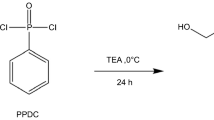Abstract
Three novel phosphorus-based flame retardant monomers were successfully prepared by reacting 1-(acryloyloxy)-3-(methacryloyloxy)-2-propanol (AHM) with hexachlorocyclotriphosphazene and characterized by FT-IR, 1H-NMR, 13C-NMR, 31P-NMR and 2D 1H-31P NMR correlation experiments. With the aid of a photoinitiator and a UV flood curing system, these monomers were cured onto cellulosic substrates to generate flame retardant coatings. An experiment was designed through SAS JMP® Pro 10 to investigate the influences of monomer concentration, photoinitiator concentration and UV exposure time on coating yield. All three monomers formed coatings under UV conditions in the presence of the photoinitiator that were durable to extraction. Burn testing showed that a loading of only 15 % of these monomers was required to prevent the substrates from combusting in the horizontal, 45° and vertical orientations. The regions of the fabric that were exposed to the flame were converted to char; a characteristic of flame retardant chemicals that function through the condensed phased. The ability of these monomers to encourage the formation of non-flammable char was further revealed by thermogravimetric analysis. Treated fabrics gave significantly elevated char yields at 600 °C. Finally, the grafted polymeric layers that were produced on the substrates were observed using scanning electron microscopy.







Similar content being viewed by others
References
Allcock HR (1972) Phosphorus–nitrogen compounds: cyclic, linear, and high polymeric systems. Academic Press, New York
Allcock HR, Hartle TJ, Taylor JP, Sunderland NJ (2001) Organic polymers with cyclophosphazene side groups: influence of the phosphazene on physical properties and thermolysis. Macromolecules 34(12):3896–3904
Brown DE, Allen CW (1991) Homo-and copolymerization of (methacryloyl ethenedioxy)pentachlorocyclotriphosphazene. J Inorg Organomet Polym 1(2):189–198
Chen-Yang YW, Chuang JR, Yang YC, Li CY, Chiu YS (1998) New UV-curable cyclotriphosphazenes as fire-retardant coating materials for wood. J Appl Polym Sci 69(1):115–122
Ding J, Shi W (2004) Thermal degradation and flame retardancy of hexaacrylated/hexaethoxyl cyclophosphazene and their blends with epoxy acrylate. Polym Degrad Stab 84(1):159–165
El-Gouri M, El-Bachiri A, Hegazi SE, Rafik M, El-Harfi A (2009) Thermal degradation of a reactive flame retardant based on cyclotriphosphazene and its blend with DGEBA epoxy resin. Polym Degrad Stab 94:2101–2106
Franklin WE, Rowland SP (1979) Effects of phosphorus-containing flame retardants on pyrolysis of cotton cellulose. J Appl Polym Sci 24(5):1281–1294
Gaan S, Sun G (2007) Effect of phosphorus and nitrogen on flame retardant cellulose: a study of phosphorus compounds. J Anal Appl Pyrolysis 78(2):371–377
Gaan S, Sun G, Hutches K, Engelhard MH (2008) Effect of nitrogen additives on flame retardant action of tributyl phosphate: phosphorus–nitrogen synergism. Polym Degrad Stab 93(1):99–108
Grune GL, Greer RW, Chern RT, Stannett VT (1994) Sensitivity enhancement of polyorganophosphazenes to radiation with 2,2,4,4,6,6-hexakis(2-hydroxyethyl methacrylate)cyclotriphosphazene monomer and its application for negative resists. J Macromol Sci A 31(9):1193–1206
Kandola BK, Horrocks AR, Price D, Coleman GV (1996) Flame-retardant treatments of cellulose and their influence on the mechanism of cellulose pyrolysis. J Macromol Sci Polym Rev 36(4):721–794
Liu R, Wang X (2009) Synthesis, characterization, thermal properties and flame retardancy of a novel nonflammable phosphazene-based epoxy resin. Polym Degrad Stab 94:617–624
Nguyen TM, Chang S, Condon B, Uchimiya M, Graves E, Smith J, Easson M, Wakelyn P (2012) Synthesis and characterization of a novel phosphorus–nitrogen-containing flame retardant and its application for textile. Polym Adv Technol 23(7):1036–1044
Nguyen TM, Chang S, Condon B, Slopek R, Graves E, Yoshioka-Tarver M (2013) Structural effect of phosphoramidate derivatives on the thermal and flame retardant behaviors of treated cotton cellulose. Ind Eng Chem Res 52(13):4715–4724
Qian LJ, Ye LJ, Xu GZ, Liu J, Guo JQ (2011) The non-halogen flame retardant epoxy resin based on a novel compound with phosphaphenanthrene and cyclotriphosphazene double functional groups. Polym Degrad Stab 96:1118–1124
Schindler WD, Hauser PJ (2004) Chemical finishing of textiles. Woodhead Publishing, Cambridge
Tao K, Li J, Xu L, Zhao X, Xue L, Fan X, Yan Q (2011) A novel phosphazene cyclomatrix network polymer: design, synthesis and application in flame retardant polylactide. Polym Degrad Stab 96:1248–1254
Wu HS, Meng SS (1998) 31P NMR analysis of cyclotriphosphazenes. Ind Eng Chem Res 37(2):675–683
Wu W, Yang CQ (2003) Correlation between limiting oxygen index and phosphorus/nitrogen content of cotton fabrics treated with a hydroxy-functional organophosphorus flame-retarding agent and dimethyloldihydroxyethyleneurea. J Appl Polym Sci 90(7):1885–1890
Xing W, Jie G, Song L, Hu S, Lv X, Wang X, Hu Y (2011) Flame retardancy and thermal degradation of cotton textiles based on UV-curable flame retardant coatings. Thermochim Acta 513(1–2):75–82
Yaguchi A, Mori S, Kitayama M, Onda T, Kurahashi A, Ando H (1992) The characteristics of cyclic phosphazene and its applications for hard coatings. Thin Solid Films 216(1):123–125
Yuan H, Xing W, Zhang P, Song L, Hu Y (2012) Functionalization of Cotton with UV-cured flame retardant coatings. Ind Eng Chem Res 51(15):5394–5401
Acknowledgments
The authors wish to express gratitude to Dr. Hanna Gracz of the NCSU BIO-NMR Facility for her help with NMR studies. We are also grateful to the National Textile Center for funding this research through project number C10-NS03.
Author information
Authors and Affiliations
Corresponding author
Rights and permissions
About this article
Cite this article
Edwards, B., Hauser, P. & El-Shafei, A. Nonflammable cellulosic substrates by application of novel radiation-curable flame retardant monomers derived from cyclotriphosphazene. Cellulose 22, 275–287 (2015). https://doi.org/10.1007/s10570-014-0497-7
Received:
Accepted:
Published:
Issue Date:
DOI: https://doi.org/10.1007/s10570-014-0497-7




